What's Ringworm and How You Treat It?
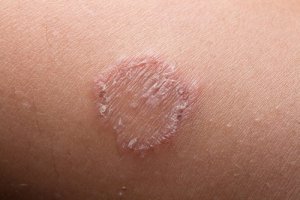

Reviewed and approved by the doctor José Gerardo Rosciano Paganelli
Ringworm is caused by a fungus. It causes small, circle-shaped rashes, according to the Mayo Clinic. Furthermore, it can appear on different regions of the body and is highly contagious, even though it isn’t a serious condition.
The “rings” can spread to other parts of the body. In more severe cases, there’ll be blisters and pus-filled sores. As occurs on the scalp with Celso’s kerion, the leading cause of alopecia, or abnormal hair loss, in children.
Complications are due to weak immune systems and treatment may extend up to three months if the fungus colonizes nails or scalp. Most cases resolve within two to four weeks. In this article we’ll tell you more about ringworm and how to treat it.
Causes and symptoms of ringworm
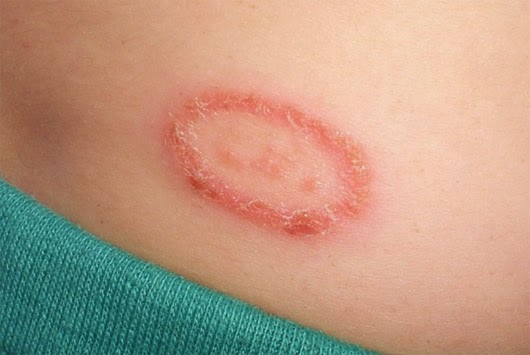
It is a condition caused by various types of fungi known as dermatophytes, that is, microorganisms that attack keratin-rich tissue, such as the skin. The most important fungal genera are Microsporum, Epidermophyton, and Trichophyton.
The symptoms of ringworm begin to appear between four to 10 days after coming into contact with the fungus.
- The first sign is a circular eruption on the skin, with slightly raised edges
- There’s a rash in the center of the patch but it’s healthy for the most part
- The itching can be unbearable but scratching will only spread the fungus further and lead to infection
Ringworm can be transmitted in many different ways, both directly and indirectly. For example, it can be contracted through direct skin-to-skin contact with an infected person or even with a pet who carries the fungus. Dogs, cats, horses and rabbits can all contract this disease.
Children are more vulnerable to this infection than adults. What’s more, there are a number of risk factors that adults should watch out for, which can increase the likelihood of contracting ringworm:
- Excessive sweating
- Living in a warm or humid area
- Wearing tight clothes
- Participating in contact sports
- Sharing clothes or towels with others
- A weak immune system
The best way to prevent ringworm is to ensure you’re not in direct contact with people who already carry the infection. Also make sure you don’t share clothing that has direct contact with the skin.
It’s important to take your pets to the vet and properly dry them after washing them (especially the areas between their toes, under the legs and their groins).
Read more: Juices to Strengthen the Immune system
Home remedies to treat ringworm
If you’re not especially keen to use medicines prescribed by a doctor, or if you just want another treatment to complement anti-fungal creams or lotions bought at the pharmacy, we recommend the following natural remedies to help treat ringworm:
1. Garlic
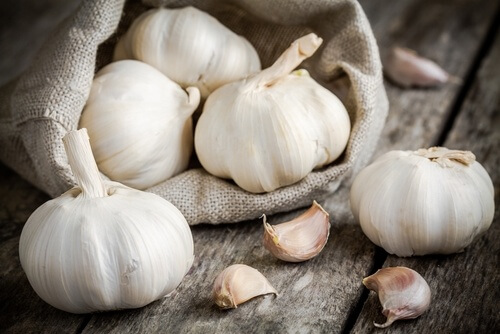
According to this study conducted by the Wakunaga Pharmaceutical Company in Japan, garlic has antifungal properties. Thus, it can help you in the treatment of ringworm. It may sting a little at first contact. However, try to keep it on as long as you can to obtain maximum benefits.
Ingredients
How to Prepare
- Peel the clove of garlic and cut it into slices
- Place it over the affected area and cover with a bandage
- Leave overnight and remove in the morning
- Repeat for at least a week, or until the lesion disappears
2. Essential Oils
Some oils have antifungal properties, as is the case of lavender, according to this study conducted by Babol University in Iran. Applying them several times a day prevents the fungus from developing further.
Ingredients
- 2 tbsp. of water (20 ml.)
- 2 tbsp. of essential oil (30 g.)
How to Prepare
- In a small bowl, mix the water and the essential oil you’ve chosen (out of either lavender or tea tree oil)
- Apply to the affected area, and cover with a cloth or gauze
- Leave on for several hours before removing the dressing
- Repeat three times a day for a month
3. Apple cider vinegar

This substance has antibiotic and antifungal properties among others, as suggested by this study conducted by the University of Taubaté in Brazil. Initial burning is normal. Thus, try use cold vinegar to soothe the symptoms.
Ingredients
- 1 tbsp. of apple cider vinegar (10 ml.)
How to make
- Moisten a piece of gauze, cloth or cotton with the apple cider vinegar
- Apply to the lesion by pressing lightly
- Allow to dry
- Repeat between three to five times a day
4. Salt and vinegar
Although this remedy can be quite irritating when it comes into contact with the affected area, it’s very effective.
Ingredients
- 1 tbsp. of salt (10 g.)
- 1 tbsp. vinegar (10 ml.)
How to make
- In a small bowl, add the salt and pour in the vinegar little by little, mixing as you go
- Form into a paste and apply directly to the lesions
- Spread carefully and leave to act for 5 minutes
- Rinse with warm water, then dry and remove any excess with a clean towel, with a gentle patting motion
- Repeat this treatment twice a day for at least a week
5. Aluminum salts
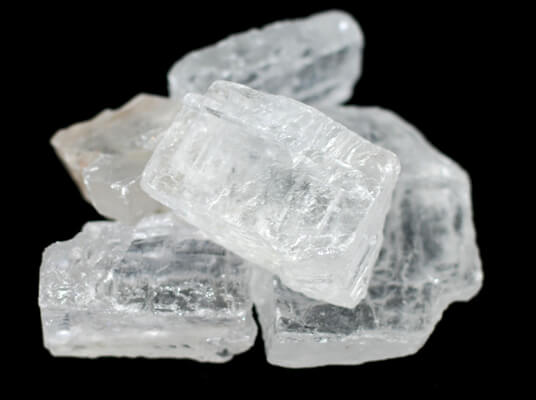
Aluminum salts aren’t antimicotic but have an antiperspirant effect. Because of this, they block the production of sweat and prevent the fungus from spreading.
Ingredients
- 1 tbsp. of aluminum salts (10 g.)
- 1 glass of water (200 ml.)
How to make
- Place the salts in a container, and slowly add the water
- Once the ingredients form a paste, apply to the injury and leave on to act for six hours (or better yet, overnight)
- After that, rinse it off with warm water and pat it dry
- Repeat every day for a week
As well as trying out the recipes we’ve shown you here, you should keep the following tips in mind to treat ringworm:
Keys to avoid the appearance of ringworm
1. Exercise proper hygiene
- Wash your hands when you get home, before eating or after going to the bathroom
- Shower every day (especially after exercise or in hot weather)
- Use neutral soaps
2. Dry yourself well before getting dressed
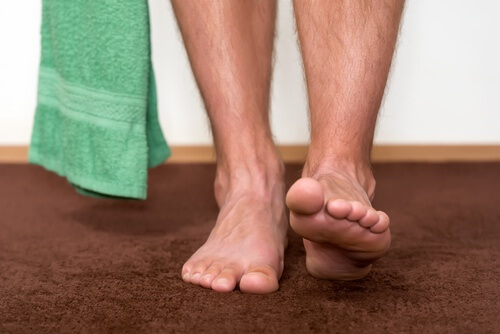
After showering, it’s important to dry properly. You must keep in mind that fungi thrive in humid environments. Thus, dry yourself with a towel and emphasize areas with creases, such as the armpits. Use talcum powder or cornmeal to keep your skin dry.
If you already have ringworm, try any of the above remedies to control the fungus. Finally, it’s important to visit a dermatologist who can make a proper diagnosis. If you don’t have this fungus, follow the above tips to keep it that way.
All cited sources were thoroughly reviewed by our team to ensure their quality, reliability, currency, and validity. The bibliography of this article was considered reliable and of academic or scientific accuracy.
- Behmanesh, F., Pasha, H., Sefidgar, A. A., Taghizadeh, M., Moghadamnia, A. A., Adib Rad, H., & Shirkhani, L. (2015). Antifungal effect of lavender essential oil (Lavandula angustifolia) and clotrimazole on Candida albicans: an in vitro study. Scientifica, 2015, 1-5. Disponible en: https://www.ncbi.nlm.nih.gov/pmc/articles/PMC4621348/
- Mayo Clinic. (2022). Tiña (corporal). Disponible en: https://www.mayoclinic.org/es-es/diseases-conditions/ringworm-body/symptoms-causes/syc-20353780
- Monzón, A., Cuenca, M. & Rodríguez-Tudela, J. L. (2003). Estudio epidemiológico sobre las dermatofitosis en España (abril-junio 2001). Enfermedades infecciosas y microbiologia clinica, 21(9), 477-483. Disponible en: https://www.elsevier.es/es-revista-enfermedades-infecciosas-microbiologia-clinica-28-articulo-estudio-epidemiologico-sobre-dermatofitosis-espana-13052330
- Ousaaid, D., Laaroussi, H., Bakour, M., Ennaji, H., Lyoussi, B., & El Arabi, I. (2021). Antifungal and antibacterial activities of apple vinegar of different cultivars. International Journal of Microbiology, 2021, 1-6. Disponible en: https://www.ncbi.nlm.nih.gov/pmc/articles/PMC8369171/
- Pinto, T., Neves, A., Leão, M. & Jorge, A. (2008). Vinegar as an antimicrobial agent for control of Candida spp. in complete denture wearers. Journal of Applied Oral Science, 16, 385-390. Disponible en: https://www.scielo.br/j/jaos/a/7qDkZ7LpJj46ZRh9jW3CFDk/?lang=en
- Rebollo, N., López-Barcenas, A. P. & Arenas, R. (2008). Tiña de la cabeza. Actas Dermo-Sifiliográficas, 99(2), 91-100. Disponible en: https://www.sciencedirect.com/science/article/abs/pii/S0001731008746301
- Yoshida, S., Kasuga, S., Hayashİ, N. O. R. I. H. I. R. O., Ushiroguchi, T., Matsuura, H., & Nakagawa, S. (1987). Antifungal activity of ajoene derived from garlic. Applied and Environmental Microbiology, 53(3), 615-617. Disponible en: https://www.ncbi.nlm.nih.gov/pmc/articles/PMC203719/pdf/aem00120-0155.pdf
This text is provided for informational purposes only and does not replace consultation with a professional. If in doubt, consult your specialist.








